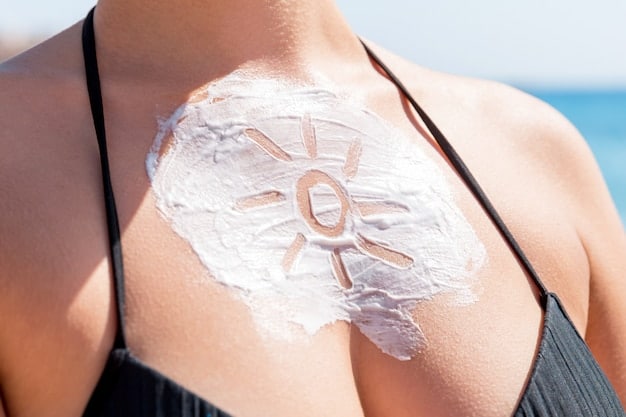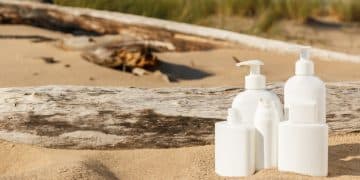Mineral vs. Chemical Sunscreen: Find Your Best Choice in 2025

Mineral and chemical sunscreens offer different ways to protect your skin from harmful UV rays; understanding their mechanisms, ingredients, and suitability for various skin types ensures you choose the best sunscreen for your needs in 2025.
Choosing the right sunscreen can be a daunting task, especially with so many options available. The debate between **mineral vs. chemical sunscreen: which is right for you? A detailed comparison for 2025** will guide you to discover the perfect sun protection.
Understanding the Basics of Sunscreen
Sunscreen is an essential part of any skincare routine, but understanding its basics allows you to make an informed choice. Both mineral and chemical sunscreens protect your skin from harmful ultraviolet (UV) radiation, but they do so through different mechanisms. Knowing these differences is key to selecting the right product for your skin and lifestyle.
What is UV Radiation?
UV radiation comes from the sun and is categorized into UVA, UVB, and UVC rays. UVA rays contribute to skin aging, while UVB rays are primarily responsible for sunburn. UVC rays are mostly absorbed by the atmosphere and don’t typically reach the Earth’s surface.
The Importance of Sun Protection
Protecting your skin from UV radiation is vital for preventing premature aging, sunburn, and skin cancer. Regular sunscreen use can significantly reduce these risks, ensuring your skin remains healthy and youthful for longer.
- Prevention of Sunburn: Sunscreen creates a barrier that absorbs or reflects UV rays, preventing painful sunburn.
- Reduced Risk of Skin Cancer: Consistent sunscreen use lowers your chances of developing skin cancer, including melanoma.
- Anti-Aging Benefits: By blocking UVA rays, sunscreen helps prevent wrinkles, age spots, and loss of skin elasticity.
Choosing the right sunscreen involves understanding the various types available, their ingredients, and how they work to protect your skin. This knowledge empowers you to make a choice that suits your needs and preferences, ensuring optimal sun protection.
Mineral Sunscreen: A Closer Look
Mineral sunscreens, also known as physical sunscreens, use mineral ingredients to create a physical barrier on the skin that reflects UV radiation. These sunscreens are often praised for their gentleness and suitability for sensitive skin.

Active Ingredients in Mineral Sunscreens
The primary active ingredients in mineral sunscreens are zinc oxide and titanium dioxide. These minerals are finely ground and dispersed in a lotion or cream base to provide broad-spectrum protection against UVA and UVB rays.
How Mineral Sunscreens Work
Mineral sunscreens work by creating a physical barrier that reflects UV rays away from the skin. When UV radiation hits the sunscreen, the mineral particles scatter the rays, preventing them from penetrating the skin.
- Reflective Barrier: Mineral particles form a layer on the skin that acts like a shield against UV radiation.
- Broad-Spectrum Protection: Zinc oxide and titanium dioxide offer protection against both UVA and UVB rays.
- Immediate Protection: Mineral sunscreens start working as soon as they are applied, without needing time to absorb into the skin.
Mineral sunscreens are an excellent choice for those seeking gentle, effective sun protection. Their natural ingredients and reflective mechanism make them a popular option for sensitive skin and environmentally conscious consumers.
Chemical Sunscreen: What You Need to Know
Chemical sunscreens use chemical filters that absorb UV radiation and convert it into heat, which is then released from the skin. These sunscreens are known for their thin texture and ease of application.
Common Chemical Filters
Chemical sunscreens contain a variety of active ingredients, including oxybenzone, avobenzone, octinoxate, and octisalate. These chemicals work by absorbing UV radiation and converting it into heat.
The Absorption Process
When UV rays penetrate the skin, the chemical filters absorb the radiation and undergo a chemical reaction that converts the UV energy into heat. This heat is then released from the skin, preventing UV damage.
Chemical sunscreens are a popular choice for many due to their lightweight feel and ease of use. However, it’s important to be aware of the potential downsides and choose products that align with your skin type and environmental concerns.
Mineral vs. Chemical: Detailed Comparison
Choosing between mineral and chemical sunscreen involves considering several factors, including skin sensitivity, environmental impact, and personal preferences. A detailed comparison can help you make an informed decision.
Skin Sensitivity
Mineral sunscreens are generally considered better for sensitive skin because they are less likely to cause irritation or allergic reactions. Chemical sunscreens, on the other hand, may contain ingredients that can irritate sensitive skin.

Environmental Impact
Mineral sunscreens are considered more environmentally friendly because their active ingredients, zinc oxide and titanium dioxide, are not known to harm coral reefs. Certain chemical filters, such as oxybenzone and octinoxate, have been linked to coral reef damage.
When choosing between mineral and chemical sunscreens, consider your skin type, environmental concerns, and personal preferences. Both types offer effective sun protection, but understanding their differences ensures you make the best choice for your needs.
How to Choose the Right Sunscreen
Selecting the right sunscreen involves understanding your skin type, lifestyle, and specific needs. Different factors such as skin sensitivity, environmental concerns, and intended use play a crucial role in your decision.
Understanding Your Skin Type
Different skin types require different formulations of sunscreen. For example, oily skin may benefit from a lightweight, non-comedogenic sunscreen, while dry skin may need a more moisturizing formula.
Considering Your Lifestyle
Your daily activities and lifestyle can impact the type of sunscreen you choose. If you spend a lot of time swimming or sweating, a water-resistant sunscreen is essential. For everyday use, a lightweight, easily absorbed sunscreen may be more convenient.
Choosing the right sunscreen is a personal decision that involves considering various factors. By understanding your skin type, lifestyle, and specific needs, you can select a product that provides effective sun protection while aligning with your preferences and values.
Application and Usage Tips for 2025
Proper application and usage are essential to ensure your sunscreen provides adequate protection. Knowing how much to apply, when to reapply, and how to store your sunscreen can maximize its effectiveness.
How Much Sunscreen to Apply
Most adults need about one ounce (two tablespoons) of sunscreen to adequately cover their entire body. This includes applying a nickel-sized amount to the face and neck.
When to Reapply
Sunscreen should be reapplied every two hours, or more frequently if you are swimming or sweating. Even water-resistant sunscreens lose effectiveness over time and need to be reapplied to maintain protection.
- Every Two Hours: Reapply sunscreen every two hours, regardless of activity level.
- After Swimming or Sweating: Reapply immediately after swimming or excessive sweating.
- Check Expiration Dates: Ensure your sunscreen is not expired, as expired products may not provide adequate protection.
Proper application and usage of sunscreen are crucial for maximizing its protective benefits. By applying enough sunscreen, reapplying regularly, and storing it correctly, you can ensure your skin remains shielded from harmful UV radiation.
| Key Point | Brief Description |
|---|---|
| ☀️ Mineral Sunscreen | Uses zinc oxide and titanium dioxide to reflect UV rays. |
| 🧪 Chemical Sunscreen | Absorbs UV rays and converts them into heat. |
| 🌱 Environment | Mineral sunscreens are generally reef-safe. |
| 👶 Skin Sensitivity | Mineral sunscreens are often better for sensitive skin. |
[Frequently Asked Questions]
▼
Mineral sunscreens use zinc oxide and titanium dioxide to create a physical barrier that reflects UV rays, while chemical sunscreens absorb UV rays and convert them into heat.
▼
Yes, mineral sunscreens are considered more environmentally friendly because they do not contain chemicals like oxybenzone and octinoxate, which can harm coral reefs.
▼
You should reapply sunscreen every two hours, or immediately after swimming or sweating, to ensure continuous protection from UV radiation.
▼
No, expired sunscreen may not provide adequate protection and should be discarded. Always check the expiration date before applying sunscreen to ensure its effectiveness.
▼
Mineral sunscreens are generally recommended for sensitive skin because they are less likely to cause irritation or allergic reactions compared to chemical sunscreens.
Conclusion
Choosing between mineral and chemical sunscreen depends on your skin type, environmental concerns, and lifestyle. Both offer effective sun protection when used correctly, so understanding their differences will help you make the best choice for your needs in 2025.





